
by Timothy Oleson Friday, January 12, 2018
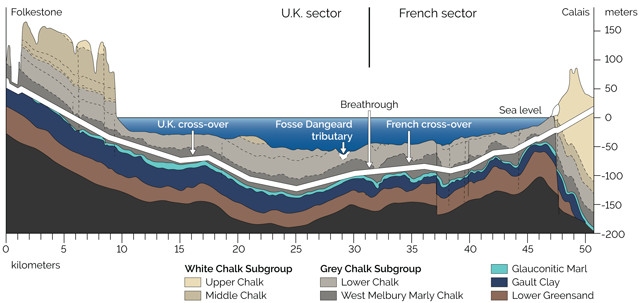
The Chunnel runs almost entirely through the West Melbury Marly Chalk. By the late 19th century, this layer had already been identified as the most suitable option for tunneling based on its strength, low permeability, ease of excavation, and depth and continuity below the channel floor. Credit: K. Cantner, AGI.
Since the tunnel connecting Britain and France beneath the English Channel opened in 1994, more than 390 million people and 320 million metric tons of goods have made the 50-kilometer subterranean trip. The Channel Tunnel, or Chunnel, which is actually three separate tunnels — two for rail traffic and one for maintenance — thus plays a major part in the countries’ economies, as well as in the broader European economy. Beyond that distinction, it has been memorialized in popular TV, movies and literature. And in recent years, the tunnel has taken on literal and symbolic significance as a gateway amid flows of refugees from strife-ridden parts of the world and in debates over immigration policy. The Chunnel has become so firmly embedded in the regional infrastructure and culture during the past quarter century that it is difficult to imagine it not being there today.
Prior to its construction, however, interest in a fixed link between Britain and France had waxed and waned, and its history — beginning in the early 19th-century — is marked by a series of stalled ventures. So even in the 1980s, when supporters once again proposed the idea, reaffirmed its technical and financial feasibility, and received the backing of the countries’ respective heads of state, the project was not a foregone conclusion.
On Feb. 12, 1986, a milestone in the effort was reached when representatives of the English and French governments met at Canterbury Cathedral to sign a treaty formalizing their bilateral agreement to move forward with a fixed-link project. Still, a multitude of obstacles remained to be navigated, from gaining the requisite political and popular support, to figuring out how and by whom it would be managed and financed, to working out countless design and engineering aspects. Fundamental among the technical challenges was assessing — via rock cores and geophysical observations — how amenable the chalk geology underlying the Strait of Dover would be to a trio of concrete-lined tubes stretching from Folkestone in southeastern England to Coquelles in northern France.
In the end, the project was completed — over budget and behind schedule, although perhaps not dramatically so given its scale and complexity — and the clay-rich chalk through which the tunnels run has held up as expected.
Detailed notions of a tunnel connecting Britain and France date back to 1802, when French mining engineer Albert Mathieu-Favier proposed that one be built beneath the English Channel. This paved tunnel would be lit by oil lamps, ventilated by chimneys, and rise to an artificial island midway across the channel, where the horses used to pull stagecoaches could be swapped and rested. Despite getting favorable attention from statesmen in both England and France, Mathieu-Favier’s idea, as well as another for a submerged sea-bottom tunnel made of iron put forward in 1803 by Englishman Henry Mottray, faltered amid rising tensions between the countries.
Subsequent attempts to study, design and initiate a cross-channel fixed link arose often from the mid-19th century through the 1970s. Proposals imagined a range of constructions and means of transport, from iron or concrete tunnels beneath or atop the seabed to various bridge schemes or bridge-and-tunnel combinations, each carrying carriages, trains or automobiles.
All of these efforts eventually failed. At times, diplomatic or military tensions between France and Britain came into play, as did fears over losing the sovereignty and security afforded by being an island (a substantial and lasting concern of many in Britain). In other cases, competing transportation interests, such as ship owners and ferry operators, mounted successful protests, or stagnating economic conditions undermined the apparent financial viability of constructing a link. Even when tensions lifted at times, or when Britain’s figurative island status eroded with the emergence of aircraft and — later — long-range weapons, or when expert panels deemed a link financially feasible, the popular and/or political will to undertake the project fizzled. After starting construction on test shafts beginning in 1973, for example, the British government backed out of an existing tunnel agreement in January 1975, citing rising cost estimates.
Despite the negative outcomes, through each unsuccessful venture engineers and scientists gained a better understanding of the technical challenges associated with such a grand construction project, spurred on by increasing curiosity about the subsurface, ever-improving technology and successful pilot projects. Thus, confidence in the basic technical practicability of a fixed link grew over time.
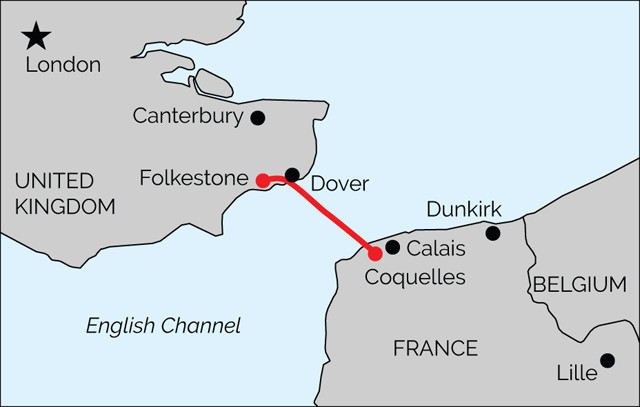
The 50.5-kilometer-long tunnel runs under land and sea between Folkestone, England, and Coquelles, France. With a 38-kilometer stretch beneath the English Channel, it is the longest undersea tunnel in the world. Credit: K. Cantner, AGI.
Geologists and other observers had long noticed the similarity of prominent chalk outcrops on the coasts of southeast England and northern France, but until the mid-19th century, little was known about the channel seabed or the rocks beneath it. So it was unclear whether the chalks represented distinct formations or continuous layers that might be favorable for tunneling. From the 1830s through the 1860s, French engineer Aimé Thomé de Gamond, who himself proposed numerous cross-channel tunnel and bridge schemes, conducted the first detailed studies. Thomé de Gamond took marine soundings to map the bathymetry of the channel floor and also — by means of rock cores and samples, which at times he collected on harrowing free dives to the seafloor — confirmed that some of the chalk layers exposed on either side of the channel were indeed continuous.
Thomé de Gamond’s work set the stage for continued hydrographic and geologic studies of the channel. The picture of the subsurface that gradually emerged showed layers of Cretaceous chalk and clay all dipping to the northeast and, for the most part, gently sloping from either shoreline under the channel floor. At the base of the thick chalk stratum was a layer of Cenomanian-aged chalk marl — now known as the West Melbury Marly Chalk — which was soon recognized as the soundest option for drilling. Free of flint and containing enough clay to make it nearly impermeable, the marly chalk layer was thick enough to host a tunnel and relatively easy to excavate. Above this layer, the chalk was more permeable and contained more fissures, and its closer proximity to the seafloor further increased the risk of flooding. Below the marl, the Gault Clay was more difficult to excavate and, though impermeable, it could swell in contact with water, which would stress tunnel linings.
In the 1870s, an idea for a tunnel proposed by British mining engineer William Low, who had briefly collaborated with Thomé de Gamond, emerged from the competition as the leading contender. Low proposed boring two parallel, one-way railway tunnels connected by cross tunnels, with the piston-like action of the trains running in opposite directions providing ventilation of train exhaust. His design would ultimately serve as the basis for the Channel Tunnel a century later. But the project based on his idea foundered in 1882, even after nearly 2-kilometer-long pilot tunnels — one in Britain and one in France — were successfully bored through the marly chalk, providing the clearest indication yet that the rock layer was suitable.
Studies continued in the 1890s and at times through the 20th century. From the late 1950s through 1988, 186 deep boreholes — 116 marine and 70 on land — were drilled as part of different feasibility investigations, adding increasing resolution and dimension to the geologic picture. In the mid-20th century, marine geophysical methods like seismic profiling and sonar also matured, offering further detail for both bored and sea-bottom tunnel proposals.
Not long after Britain canceled the existing tunnel project in 1975, the issue was raised anew. Supporters, recognizing the increasing interconnectedness of the regional and global markets, touted the potential economic benefits of a fixed link, as well as the opportunity to ease cross-channel transportation. Margaret Thatcher, who became prime minister of the U.K. in 1979, was more amenable to the idea than her predecessors. And she found a willing partner in François Mitterrand, who’d won the French presidency in May 1981. By later that year, the leaders agreed to begin looking into a new venture.
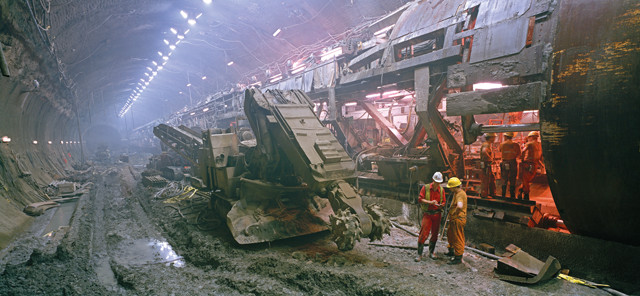
Engineers in the U.K. cross-over tunnel, with one of the massive boring machines used during construction. Credit: qaphotos.com/Alamy Stock Photos
Study groups concluded that a fixed link across the channel would ultimately prove beneficial to both countries’ economies and that it was financeable, provided the funding came from private sources. Design proposals were solicited in early 1985, and by the end of October that year, four finalists were selected: Eurobridge, a suspension bridge carrying a fully enclosed multilevel roadway; Euroroute, a combination of tunnels, bridges and artificial islands; the Channel Expressway, a set of four tunnels for both rail and road traffic; and Eurotunnel, a two-tunnel design similar to Low’s that would carry trains loaded with passengers, vehicles and freight.
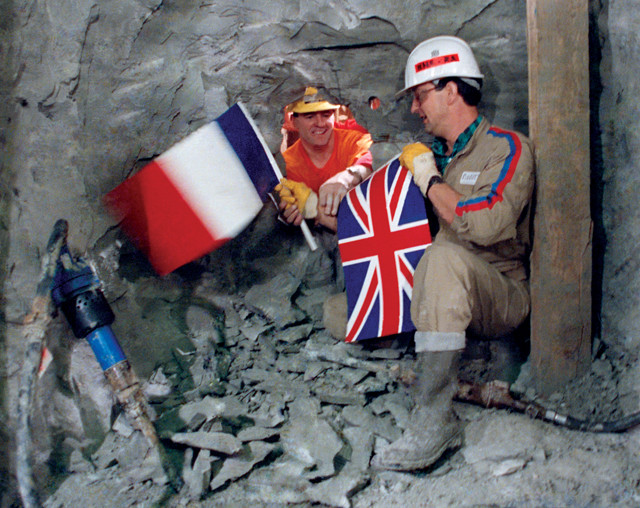
English worker Robert Graham Fagg (left) and French worker Philippe Cozette (right) trade flags to celebrate breaking through the last bit of rock between the French and British construction teams in the maintenance tunnel in December 1990. Credit: qaphotos.com/Alamy Stock Photos.
In January 1986, the Eurotunnel bid, put forth by a consortium of private British and French construction contractors and banks, was announced as the winner. A few weeks later, on Feb. 12, Thatcher and Mitterrand met in front of media and spectators in Canterbury Cathedral — chosen for its symbolism as a pillar of English history built from French stone, as well as its proximity to where the tunnel would be built — where the countries’ foreign secretaries signed the Channel Fixed Link Treaty, also called the Treaty of Canterbury. The treaty officially established the concession that granted the Eurotunnel group the power to build and operate the tunnel for 55 years (later extended to 65 years, then again to 99 years), after which time ownership would revert to the two national governments. It also created intergovernmental monitoring and safety authorities to oversee construction and operation.
In remarks to the assembled crowd, Thatcher said the treaty’s signing “has brought to the brink of fruition a project that has challenged engineers, entrepreneurs and governments on both sides of the channel for generations.” Mitterrand, in turn, commented that “there will come a time soon when the cross-channel fixed link will be part of the geological scenery of our planet.”
Following the treaty signing, the Eurotunnel consortium embarked on a frantic months-long dash to secure the billions of pounds of needed funding from private investors and banks worldwide, to finalize design and construction plans, and to win over enough skeptics in the British Parliament to gain its final approval authorizing the project (legislative approval was not required by law in France). The group eventually succeeded, and construction began in late 1987; with the bilateral nature of the agreement and the necessity to minimize construction time, British and French crews worked simultaneously from their respective ends.
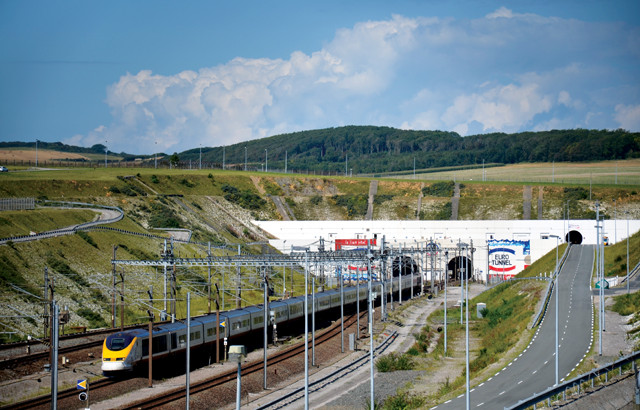
A passenger train emerges from the Channel Tunnel at the terminal in Coquelles, France, near Calais. Credit: Billy69150, CC BY-SA 4.0.
class=““caption”>Three years later, in December 1990, British and French teams working on the service tunnel broke through the last bit of rock between them. The moment is memorialized in photographs of Englishman Robert Graham Fagg and Frenchman Philippe Cozette — construction workers who’d each won the honor in a lottery — shaking hands and exchanging flags through a small hole. This was followed, in spring 1991, by breakthroughs in each of the 7.6-meter-diameter rail tunnels.
Construction of the three tunnels, along with two cross-over tunnels and the rail terminals at either end, was completed in 1993, and by early 1994, equipment had been installed and testing was largely completed. In May 1994, about a year after it was originally planned to open, the Eurotunnel was officially opened by Mitterrand and Queen Elizabeth II. All told, 11 boring machines and more than 13,000 workers, working in round-the-clock shifts, were employed on the project. The estimated final cost was 4.65 billion pounds (at 1985 prices) — equivalent to about 12.9 billion pounds in 2016 — reportedly representing an 80 percent cost overrun, which was partly ascribed to increasingly stringent safety and environmental standards enacted during the project, and to rising inflation and interest rates.
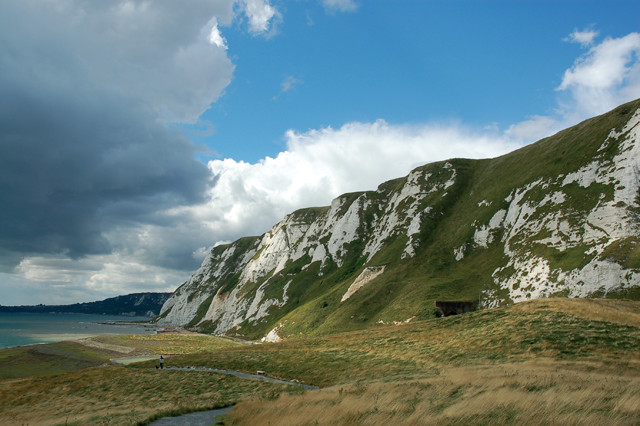
Spoils from construction of the Channel Tunnel were deposited off Shakespeare Cliff near Dover, England, and were then turned into Samphire Hoe Country Park. Credit: Alfred Gay, CC BY-SA 3.0.
espite technical and financial problems since the Channel Tunnel’s opening — including several fires and breakdowns, and the bankruptcy of the Eurotunnel company (renamed Getlink last November) in 2006 — ridership and freight numbers have grown steadily in its 20-plus years of existence. In recent years, roughly 21 million passengers and more than 20 million tons of cargo have made the under-channel crossing between Britain and France each year, about three times more than in 1995, its first full year of operation.
At its deepest, the Channel Tunnel sits 115 meters below sea level and under 75 meters of rock cover. The route of the 50.5-kilometer-long tunnels, running under land and sea between Coquelles, near Calais, and Folkestone, takes them almost entirely through the marly chalk, identified more than a century earlier as the most structurally sound option. Midway across, they also skirt within several hundred meters of the Fosse Dangeard, an 80-meter-deep sediment-filled paleovalley carved by a river system during the last ice age and first identified by geophysical surveys in the 1960s.
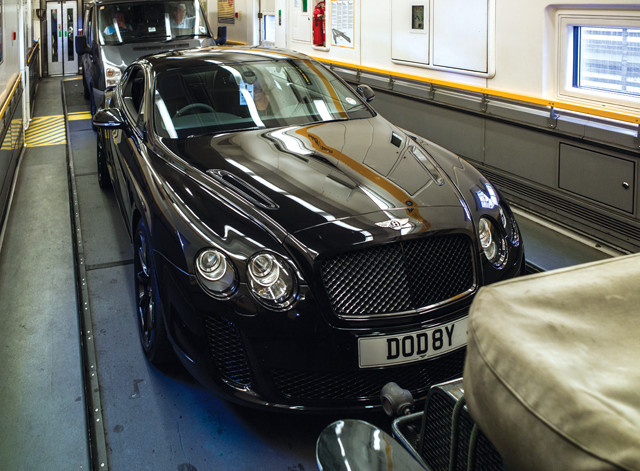
Individuals can traverse the Chunnel in passenger trains or aboard a vehicle-ferrying line. Credit: Adam Singer, CC BY-ND 2.0.
Excavation from the French side, which has steeper-dipping strata, more substantial folding and faulting that warped these strata, and brittler rock, proved more challenging and slower-going, which in part accounted for the tunnel breakthroughs occurring closer to France. Spoil from the excavation amounted to roughly 10 million cubic meters. Most of this was deposited in lagoons in France and England, including about 4.9 million cubic meters that was unloaded just off England’s Shakespeare Cliff west of Dover. The roughly 36 hectares of new land was subsequently landscaped and converted into Samphire Hoe Country Park, which now has more than 80,000 visitors annually.
Clearly, the Chunnel has not only become part of the economic and cultural scenery of Europe, but also, as Mitterrand predicted, part of the region’s geological scenery.
© 2008-2021. All rights reserved. Any copying, redistribution or retransmission of any of the contents of this service without the expressed written permission of the American Geosciences Institute is expressly prohibited. Click here for all copyright requests.